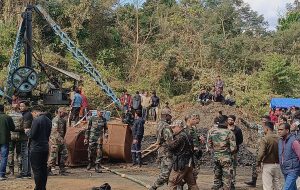A tragedy in a coal mine in the northeastern Indian state of Assam has turned the spotlight once again on the illegal practice of rat-hole mining, which thrives in the region despite a ban by the Supreme Court.
Four dead bodies of miners were retrieved last month from a flooded coal mine at Umrangso in Assam’s Dima Hasao district after water from a nearby unused mine suddenly flooded the site. Employees of the quarry were quoted as saying that there were around 15 workers trapped inside the mine, but the government did not confirm the number.
Navy divers from Vishakapatnam, army personnel, and rescue specialists from other government departments were engaged after a task force was hurriedly formed for the rescue operation. The mine has a 6-meter radius and is about 91 meters deep. The water level inside it has risen to more than 30 meters.
However, the reason for the flooding is yet to be ascertained.
Assam Chief Minister Himanta Biswa Sarma said that the coal mine appeared to be “illegal” after a person was arrested in connection with the disaster. The government has ordered a judicial probe into the incident; a police Special Investigation Team has been formed, and payment of 1 million rupees ($11,430) will be offered to each of the victim’s families.
The Gauhati High Court has issued notices to the government demanding accountability for the rat-hole coal mining operations. The court has also issued notices to seven key government departments after a suo moto public interest litigation was initiated.
The National Green Tribunal, a specialized body equipped with the necessary expertise to handle environmental disputes involving multi-disciplinary issues, banned rat-hole mining in 2014 on the grounds that the practice was unscientific and unsafe for workers. The order was later upheld by the Supreme Court. However, the order continues to be violated in several states due to the government’s failure to check the practice.
A rat-hole mine entails digging small tunnels, usually only 3-4 feet deep, through which workers crawl to extract coal with crude methods. Such mines usually come in two types: Side-cutting mining is usually done on hill slopes while box-cutting entails digging a circular or square pit, through which the diggers crawl inside. Extraction of coal is done clandestinely since the practice is illegal.
Assam and other states of India’s northeastern region have coal reserves. However, commercial mining is unfeasible given the difficult terrain as well as the nature of the deposits. The excess sulfur content in the coal reserves reduces the energy efficiency, making the coal unfit for commercial use.
The opposition Congress in Assam has alleged that there is a nexus between the illegal mining and politicians and functionaries running the Dima Hasao Autonomous Council in whose jurisdiction the coal mine of Umrangso is located. Politicians in the council claimed they were unaware of any illegal activities in the coal mines. The BJP is in power both in the state and autonomous council.
After the recent incident, the government has launched a crackdown on all illegal rat-hole mines in Assam. As many as 220 such mines were identified in Umranghso alone. The crackdown also saw the shutting down of 234 illegal mines in Tinsukia, located on the eastern tip of the state bordering Arunachal Pradesh, which has long been a hub of such activities.
The incident in Umrangso and the subsequent crackdown came on the heels of inquiries by the government. A voluminous report, which was submitted by the Justice (Retd) B. P. Katakey Commission more than three years ago, noted how the government-owned North Eastern Coalfields (NEC) was engaging in the rat-hole mining illicitly for many years after its mining rights had expired.
Despite these reports, rat-hole mining has continued under the very nose of the government without the kingpins ever being nabbed. The traders who employ the diggers operate hand-in-glove with a section of government officials, including the police, whose role has been referred to in the Katakey Commission report and also mentioned in an earlier report compiled by the police.
Besides Assam, illegal rat-hole mining and accidents are rampant in other states of the country’s northeastern region. Last year, in January, six workers were killed after a fire broke out in a rat-hole coal mine in Nagaland. In 2018, at least 15 men were stuck in a coal mine in Meghalaya after water from a nearby river flooded it. Only five among them managed to escape, as rescue efforts lasting for several weeks failed to rescue the others who were trapped.

































